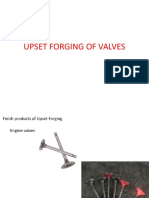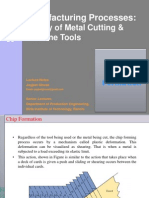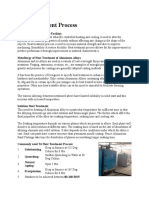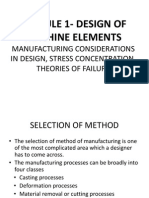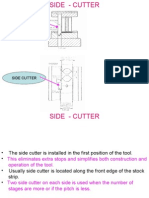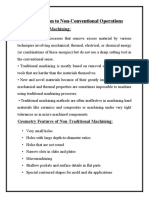Forging Process PDF
Forging Process PDF
Uploaded by
SantoshCopyright:
Available Formats
Forging Process PDF
Forging Process PDF
Uploaded by
SantoshOriginal Title
Copyright
Available Formats
Share this document
Did you find this document useful?
Is this content inappropriate?
Copyright:
Available Formats
Forging Process PDF
Forging Process PDF
Uploaded by
SantoshCopyright:
Available Formats
FORGING PROCESS
• Forging is the operation where the metal is heated and then a
force is applied to manipulate the metal in such a way that the
required final shape of the metal is obtained. Forging is generally
hot working process though cold working is also used sometimes
• it is also explained as controlled plastic deformation of metals at
elevated temperature to a tune of 1000 degree C into a
predetermined size of shape using compressive forces exerted
through some type of die by a hammer. By definition, forging
involves the shaping of metal by the application of impact load
on preheated metal at which the metal entirely plastic and will
flow under pressure into to the shape of the die .
• Forging Hammer or Hydraulic Forging presses are used for
forging. The forging hammers have a relative high rate of
deformation then the hydraulic presses.
• Since the forging is a hot working process done a elevated
temperatures, the original crystals are deformed and new
crystal with new grain structures are formed and because of
the high temperature many of the impurities are
precipitated .
• The raw material for forging is usually a bar, billet of blank .
• The temperature range of forging plain carbon steels
depends on the percentage of carbon The steels with
carbon content of o.2 % the temperature range is 1150 to
1300 degree C whereas for steels with carbon content of
0.7% the temperature range is 1000 to 1500 degree C
ADVANTAGES OF FORGING
• The forged components have high strength and ductility and
offers a high resistance to impact and fatigue .
• Forging improves the internal structure of the metal and
hence mechanical properties are also improved .
• Forging renders the parts uniforms in density and
dimensions.
• it permits Weight and cost reduction.
• Forging eliminates porosity of the parts and hence makes its
more strong
LIMINATIONS OF FORGING
• Initial cost of the Dies and tools and their maintenance is
high.
• Some materials cannot be workable by forging.
• Forging operations is limited to simple shapes. Complicates
shapes of parts cannot be forged. Forging is also limited for
the parts having undercuts and very thin sections, ribs etc.
• Because of elevated temperature, rapid oxidation of metal
surface result oxidation
FORGING OPERATIONS
• The material available for forging is in the shape of bar of billets.
the formations of the forging shape consists of a combination of
two or more number of relatively simple operations as
• Drawing down or Swaging
• Upsetting
• Punching
• Setting Down
• Bending
• Welding
• Fullering
• Blocking
• Trimming
• Edging
Drawing down of Swaging
• it is the operation of spreading or thinning action and is
accomplished by striking the work with flat dies. Due to
impact of die on metal, its thickness is reduced and length is
increased.
Upsetting
• it is must opposite to Drawing. It involves increasing the cross
sectional area usually by pressing or hammering in the
direction parallel to the original ingot axis. In upsetting
process, the bar of shaft is generally griped indies and the
head or flange done by plain flattened ram of the press.
Punching
• It is the process of producing the holes generally cylindrical
by using a hot punch over a cylindrical die.
Setting downset
• It is a local thinning down operation effected by the set of
hammers. Usually the work is fullered at the place where the
setting down commences.
• Bending
• bending operation is performed by hammering the meta
lover the edge of the anvil or a block of metal held in vice.
This operation Bending is done on the bend parts .
Welding
• Metals like wrought iron ad steels are welded by pressing
together the two surfaces. After they have been raised to the
correct welding temp
Cutting
• In order to perform a rapid cutting operation by chiseling, the
metal is heated to temp of 850 to 9000 degree C and then
hammered blows are directed on the head of the chisel.
Fullering
• This operation is same as setting down and consists of reducing
cross section of the workpiece of lengthening of the stock for
subsequent operation.
Blocking
• it is the term applied to operation of giving and intermediate shape to
the work. It follows fullering and precedes for the final finished shape.
The number of Blocking dies depends upon the size and shape of the
required part.
Trimming
• Trimming is the operation of removing the flash unwanted material
from a forged part. It is usually one by a Press
Edging
• also called PREFORM this stage is required to gather the exact amount
of the material required at each cross section of the finished
component, This the most important stage in forging.
Flat Die Forging
• It is the simplest form of forging wherein the stock is placed
on the anvil and the hammer pressed form its own face
upon he work. The work may be turned either by tongs of
machine called manipulator This operation much depends
upon the skill of the operator. This operation is used for bulky
and simple shaped components
Impression or Closed die forging
• This process is used to forge intricate shaped components'
piece of heated metal is placed on the lower part of the die
block. The metal is forced to take the shape of the die
(Upper and Lower) by blow of a machine called hammer,
CHARACTERISTICS OF FORGED
PARTS
# It refines the structure of the forged part
# Forged parts have directional properties and hence have
good strength
# Cracks and blow holes in forged pars are minimized or
eliminated
# Mechanical properties are improved
DEFECTS IN FORGED PARTS
• If the dies are not aligned correctly, mismatch in the surfaces of the forged parts are
observed,
• Defects resulting form the melting, such as dirt slag and blow holes
• Defects resulting from improper heating and cooling forging such as burnt metal
decarburized steels and flakes. Etc
• Defects resulting from improper forging such as cracks etc.
• Unfilled Sections. In this some sections of the die cavity ae not completely filled
• Cold Shut this appears as a small cat the corners of the forging. This is caused mainly by the
improper design of die wherein the proper radius at the corner are not provided and ends up
as a cold shut.
• Scale pits This is seen as irregular depression on the surface of forged parts. This is primarily
caused because of the improper cleaning of the stock used for forging. Oxides and scales
present on the stock surface get embedded in the finished surface
• Die draft this is caused by misalignment of the two die halves making the, two halves of the
forging to improper shape,
• Improper grain flow This is caused by the improper design of the die which makes the flow of
the metal not following the final intended direction,
METHODS OF FORGING/TYPES OF
FORGING
Here are usually four methods of Forging Generally used:
• Smith Forging
• drop Forging
• Press Forging
• Machine Forging
SMITH FORGING
• Smith forging is the traditional forging process done openly or in open die by
the villager blacksmiths By manual hammering of power hammering. The
process involves heating the stock in the blacksmiths hearth and then
beating it over the anvil. To get the desired shape, the operator has to
manipulate the component in between the blows. The types of operation
available are as fullering, flattening, bending upsetting and swaging etc.
• In fullering, the material cross section is decreased and length is increased..
to do this the bottom fuller is kept in the anvil with the heated stock over the
fuller, The o fuller is then above the stock and then with the sledge hammer,
the forces is applied on the top fuller.
• After fullering, the stock will gave fuller marks which are removed by
flattening method..
You might also like
- B.SC Nursing Research ThesisDocument70 pagesB.SC Nursing Research ThesisPriyanka SharmaNo ratings yet
- Per-Olov Kindgren-I Dream of YouDocument3 pagesPer-Olov Kindgren-I Dream of YouMajlaGézaNo ratings yet
- Machine Tools and Digital Manufacturing (MTDM) : Machining ProcessDocument90 pagesMachine Tools and Digital Manufacturing (MTDM) : Machining ProcessLibin AbrahamNo ratings yet
- Press WorkDocument42 pagesPress WorkanilNo ratings yet
- Upset Forging of ValvesDocument10 pagesUpset Forging of ValvesSankar KumarNo ratings yet
- Explosive WeldingDocument18 pagesExplosive WeldingShivam SharmaNo ratings yet
- Our Lady of Lourdes Academy of Tagkawayan, IncDocument4 pagesOur Lady of Lourdes Academy of Tagkawayan, IncJOSWINA CARRANZA100% (2)
- Forging Processes: Satya Amarnadh ParimiDocument26 pagesForging Processes: Satya Amarnadh ParimiamarparimiNo ratings yet
- Blanking & Piercing (Handout)Document50 pagesBlanking & Piercing (Handout)banana100% (1)
- Metal FormingDocument80 pagesMetal FormingIbrahim Mehkri100% (1)
- My ForgingDocument20 pagesMy ForgingRam Janm SinghNo ratings yet
- Metal CastingDocument12 pagesMetal CastingChinmay Das100% (4)
- Forging Processes MEE 3024 2014Document36 pagesForging Processes MEE 3024 2014krunal07786No ratings yet
- CHAPTER 11 Metal Casting ProcessDocument50 pagesCHAPTER 11 Metal Casting Processمحمد القدومي100% (1)
- Single Point Cutting ToolDocument16 pagesSingle Point Cutting ToolSoumik DasNo ratings yet
- Machining ProcessDocument23 pagesMachining ProcessAshish KatariaNo ratings yet
- MD Design ConsiderationDocument18 pagesMD Design ConsiderationjhpatelNo ratings yet
- Chip Formation and Tool LifeDocument37 pagesChip Formation and Tool LifeSquakx BescilNo ratings yet
- RollingDocument3 pagesRollingMuhammad YasirNo ratings yet
- Forging Operations: 1: DrawingDocument4 pagesForging Operations: 1: DrawingvijayakumarNo ratings yet
- Sp. Casting ProcessesDocument71 pagesSp. Casting Processesakshatkumargarg 2K20PE09No ratings yet
- MP-I - Unit 5 - Sheet Metal WorkingDocument60 pagesMP-I - Unit 5 - Sheet Metal WorkingTirumala Height Phase-INo ratings yet
- Hot Working Cold WorkingDocument2 pagesHot Working Cold WorkingBivas Panigrahi100% (1)
- Forging FundamentalsDocument23 pagesForging FundamentalsJoNo ratings yet
- Shot Blasting Is A Rapid, Environment Friendly, CostDocument10 pagesShot Blasting Is A Rapid, Environment Friendly, CostSulfikar SalimNo ratings yet
- UNIT 3 Ferrous and Non Ferrous MetalsDocument68 pagesUNIT 3 Ferrous and Non Ferrous MetalsAmutha PSGRKCWNo ratings yet
- Workshop ManualDocument13 pagesWorkshop ManualAgnivesh SharmaNo ratings yet
- Design of Cutting Die, Bending Die & Drawing Die-Practical-1Document15 pagesDesign of Cutting Die, Bending Die & Drawing Die-Practical-1Iyappan AlagappanNo ratings yet
- Theory of Metal CuttingDocument24 pagesTheory of Metal CuttingOmkar BedadeNo ratings yet
- Sheet Metal WorkingDocument66 pagesSheet Metal Workingsamurai7_77No ratings yet
- Sheet Metal Forming WorkshopDocument7 pagesSheet Metal Forming WorkshopIbrahim Khaled0% (1)
- Heat Treatment of MetalsDocument44 pagesHeat Treatment of Metalsikram7550100% (2)
- Drilling Operations l3 NotesDocument21 pagesDrilling Operations l3 Notesishimwe kwizera willyNo ratings yet
- Design and Analysis of Pressure Die Casting For Door HandleDocument6 pagesDesign and Analysis of Pressure Die Casting For Door HandleEditor IJTSRDNo ratings yet
- Heat TreatmentDocument2 pagesHeat TreatmentAnonymous XClYkdKyNo ratings yet
- Forming Processes (MP Module 3)Document77 pagesForming Processes (MP Module 3)Kailas Sree ChandranNo ratings yet
- Module 1 - Design Considerations DMEDocument59 pagesModule 1 - Design Considerations DMEsreeramhariharanNo ratings yet
- Carpentry Shop FinalDocument36 pagesCarpentry Shop FinalRakesh Kumar Shukla KECNo ratings yet
- Metal Forming Machines: PressesDocument35 pagesMetal Forming Machines: PressesMohammed Alnashar0% (1)
- Casting ProcessDocument53 pagesCasting ProcessSenthilKumar SubramanianNo ratings yet
- 4 Sheet MetalDocument54 pages4 Sheet MetalShashank PansariNo ratings yet
- Abrasive Jet Machining (AJM)Document31 pagesAbrasive Jet Machining (AJM)Abhishek KumarNo ratings yet
- Types of Press Tools - Wikipedia PDFDocument24 pagesTypes of Press Tools - Wikipedia PDFAvula Vinay100% (1)
- Bending and Drawing DieDocument7 pagesBending and Drawing Diepratik thakareNo ratings yet
- Which ToolDocument11 pagesWhich ToolJJ ROETSNo ratings yet
- Lab Report Die CastingDocument12 pagesLab Report Die CastingaaqibaminNo ratings yet
- Rolling Processs and MillsDocument14 pagesRolling Processs and MillsOm LokhandeNo ratings yet
- Design of Single Point Cutting ToolDocument11 pagesDesign of Single Point Cutting ToolSiddharth Dubey100% (1)
- Side CutterDocument7 pagesSide Cutterbabuty100% (2)
- ExtrusionDocument26 pagesExtrusionArvind BhosaleNo ratings yet
- U-4 Surface Finishing ProcessDocument38 pagesU-4 Surface Finishing Processapi-271354682100% (1)
- V BendingDocument4 pagesV BendingSufyan ZaighumNo ratings yet
- Mechanical Working of MetalsDocument103 pagesMechanical Working of Metalsgosaye desalegnNo ratings yet
- Chapter 14 Forging of MetalsDocument49 pagesChapter 14 Forging of MetalsVaisakh PsNo ratings yet
- Unit 5: Heat Treatment Processes: FundamentalsDocument53 pagesUnit 5: Heat Treatment Processes: FundamentalsPriyanka SinghNo ratings yet
- ME2252 - Manufacturing Technology-IiDocument40 pagesME2252 - Manufacturing Technology-Iiraoli411No ratings yet
- Introduction To Non Conventional OperationsDocument13 pagesIntroduction To Non Conventional Operationssham javed100% (1)
- LATHE - WriteupDocument21 pagesLATHE - WriteupMERISH GURU100% (1)
- Fundamentals of Metal Cutting and Machining Processes: Lecture 6-7Document150 pagesFundamentals of Metal Cutting and Machining Processes: Lecture 6-7Sibu SibuNo ratings yet
- Die-Casting Process: Types, Applications & LimitationsDocument24 pagesDie-Casting Process: Types, Applications & LimitationssoorajNo ratings yet
- ForgingDocument60 pagesForgingnajeebayyaril6No ratings yet
- Unit III - Bulk Deformation ProcessesDocument48 pagesUnit III - Bulk Deformation ProcessesRavitej SuraparajuNo ratings yet
- ProcessDocument27 pagesProcessSantoshNo ratings yet
- 2 MFTDocument15 pages2 MFTSantoshNo ratings yet
- Metal FormingDocument12 pagesMetal FormingSantoshNo ratings yet
- Extrusion Complete PDFDocument22 pagesExtrusion Complete PDFSantoshNo ratings yet
- LESSON 1 Teaching English in Elem GradesDocument8 pagesLESSON 1 Teaching English in Elem Gradesbaunsit.josepharnold.mccNo ratings yet
- Study Guide For MGR Exam 2 PDFDocument10 pagesStudy Guide For MGR Exam 2 PDFRandyNo ratings yet
- Official Membership FormDocument2 pagesOfficial Membership FormjilbayambangNo ratings yet
- Designing Strategy For Cultural Change PPT MBADocument11 pagesDesigning Strategy For Cultural Change PPT MBABabasab Patil (Karrisatte)No ratings yet
- Pierlite-Dled9 Led TrofferDocument2 pagesPierlite-Dled9 Led TrofferPiZarezČetrnaestNo ratings yet
- Motivation Concepts To ApplicationDocument8 pagesMotivation Concepts To ApplicationJITESHNo ratings yet
- Health Problems VOCABULARYDocument2 pagesHealth Problems VOCABULARYArlet MoralesNo ratings yet
- 2010.04.21 - 1 Cor 10.13 - 15.58 - Be SteadfastDocument1 page2010.04.21 - 1 Cor 10.13 - 15.58 - Be SteadfastJohn R. GentryNo ratings yet
- Guliyeva Hijran Latif GiziDocument2 pagesGuliyeva Hijran Latif GiziNazaNo ratings yet
- Article of FaithDocument9 pagesArticle of FaithStoryKing100% (2)
- On The Ruling of TawassulDocument16 pagesOn The Ruling of TawassulFP100% (1)
- Egain11 4 Results First AnalyticsDocument35 pagesEgain11 4 Results First AnalyticsErnestNo ratings yet
- Macmillan Natural and Social Science 2: Introduction To The CourseDocument2 pagesMacmillan Natural and Social Science 2: Introduction To The CourseAnita Vazquez CombradoNo ratings yet
- Enrollment Forecasting For School Management System: Rabby Q. Lavilles and Mary Jane B. ArcillaDocument6 pagesEnrollment Forecasting For School Management System: Rabby Q. Lavilles and Mary Jane B. Arcillachristopher hernandezNo ratings yet
- Hare Krishna1!Document44 pagesHare Krishna1!api-3697173No ratings yet
- Purushottam TandonDocument2 pagesPurushottam Tandondeeptisengar89357No ratings yet
- CTM 2Document9 pagesCTM 2AGABA DANCUNNo ratings yet
- Ohio State's Three-Deep Coverage PrinciplesDocument3 pagesOhio State's Three-Deep Coverage PrinciplesMichael SchearerNo ratings yet
- Pre-Test - Science 4Document4 pagesPre-Test - Science 4Jonalyn AntonioNo ratings yet
- 5-Third Eye Project KPDocument35 pages5-Third Eye Project KPNexus vijayawadaNo ratings yet
- The Dark Side of Digital HumanitiesDocument14 pagesThe Dark Side of Digital Humanitiessongaeyun0120No ratings yet
- UAS 7 SMP 2023 MadahikDocument6 pagesUAS 7 SMP 2023 MadahikDinda SariNo ratings yet
- 2.1.4 Planning and Cash Flow (2 Feb 2022)Document10 pages2.1.4 Planning and Cash Flow (2 Feb 2022)Ayan KhanNo ratings yet
- Benchmarking of Oneplus-76Document11 pagesBenchmarking of Oneplus-76Hemasri ChinnuNo ratings yet
- Lion Air ETicket (NOJVOA) - MubarokDocument3 pagesLion Air ETicket (NOJVOA) - MubarokDekaNo ratings yet
- 00 Midgard RPGDocument2 pages00 Midgard RPGPaul SavvyNo ratings yet
- Past-Tenses 62248Document3 pagesPast-Tenses 62248Gabriela LazarteNo ratings yet




